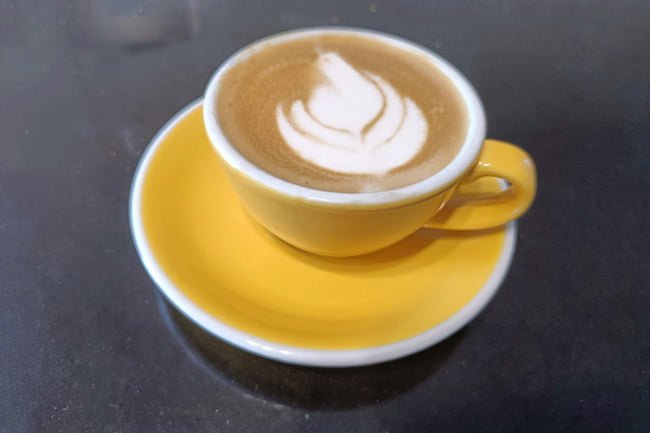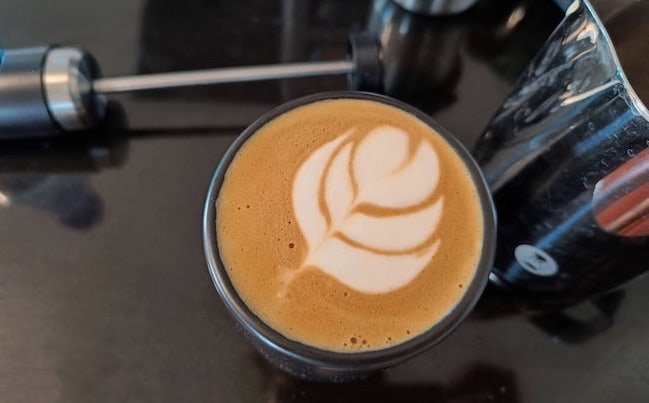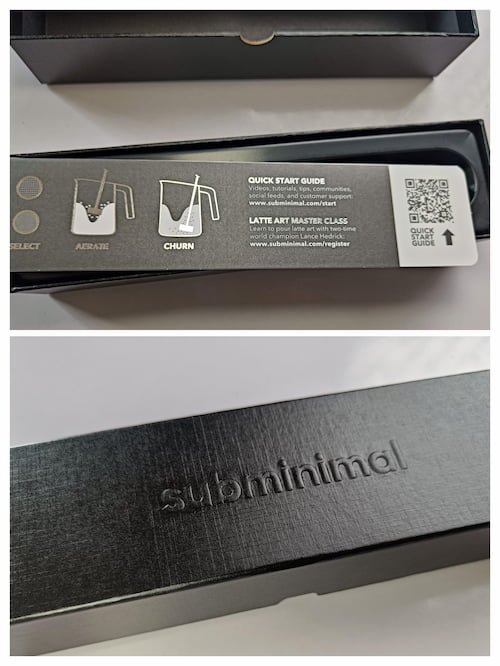For many budget-conscious espresso enthusiasts, achieving latte art-worthy microfoam has long been a challenge.
Back in the days, perfectly foamed milk was often limited to those with access to high-quality espresso machines with powerful steam wands.
The Subminimal NanoFoamer aims to level the playing field, making perfectly steamed milk more accessible to a broader audience.
In this review, I’ll examine the NanoFoamer, its features, and whether it delivers on its promises.
About Subminimal
As so many other coffee brands nowadays, the NanoFaomer began its existence as a Kickstarter project. The company behind it, Subminimal, is founded by industrial designer Dominic Symons and is now based in Singapore.
After identifying a gap in the market for milk frothers capable of producing microfoam like a real steam wand, the NanoFoamer was conceived.
Developing the first version took two years, with Dominic testing various methods and prototypes using different milk types and temperatures.
Unlike traditional frothers, the NanoFoamer aims to generate real “wet paint” milk similar to what you experience in the café rather than the kind of clumpy, whipped foam, which doesn’t work well for latte art.
The first Kickstarter campaign for the NanoFoamer raised over $385,000 with support from 5823 backers.
Since the original NanoFoamer was funded, two new upgrades have been released: a V2 and a “lithium” version with a built-in battery.
Packaging and First Impressions
The NanoFoamer’s packaging and unboxing experience stands out, filled with clever details and thoughtful touches that demonstrate the company’s attention to design.
The quality of the packaging, component layout, and overall presentation evokes a design-thinking approach reminiscent of high-end products, where every aspect of the customer experience is taken into account.
The box included a charging cable, a travel case, and a wall mount.
I tested the upgraded V2, featuring a built-in battery that charges via USB-C, and I would highly encourage you to pay a bit extra and go for that version as well (changing batteries in the middle of making a cappuccino just sounds like a nightmare🙅).
The product itself does feel like a more than decent quality. Having recently tested a range of milk frothers, I was pleasantly surprised with how strong and sturdy the wand felt.
The handle is plastic, but does feel nice enough to hold. And the button has an okay tactile feedback when pressed. You press it once to turn it on, and then it will start with a lower RPM before hitting max speed. Click it once more, and you enter “slow” mode, which makes it a bit easier to control the vortex. One more click, and the device turns off.
Overall, easy and intuitive.
Who is it for?
Traditionally, beautiful lattes and cappuccinos were limited to those who could afford expensive espresso machines with real steam wands.
For some bizarre reason most entry-level espresso makers were equipped with pannarello steam wands more capable for frothy cappuccino foam and less so for micro foam.
Many home-baristas had to resort to frothing latte art milk in a French press by whisking vigorously with the filtration screen.
Classic milk frothers don’t do a great job either.
So, the NanoFoamer is an affordable and superior alternative to all these options.
Additionally, it serves as a practical solution for users of manual espresso makers—a segment of the market that has grown in recent years with machines like the Flair 58 and Robot, which lack built-in steamers. These users can now enjoy a range of espresso-based beverages without compromising foam quality.
Another group of potential buyers includes people who want a good latte while traveling. Its portable design allows for easy transportation, making it convenient to have quality frothed milk wherever you are.

Does the Nanofoamer Deliver on Its Promises?
The NanoFoamer uses a different type of frothing technology compared to regular foamers. It has an impeller that spins at high speeds, forcing milk (and plant milk for that matter) through a tiny screen. This is in contrast to the dominant type of frother that is essentially whisking.
When using the NanoFoamer, I found it effective in producing the desired microfoam texture, even though I am not a latte art expert.
While a traditional steam wand requires some practice, the NanoFoamer is no different.
However, the brand provides clear instructional videos to help users master the process, from introducing air to creating the famous vortex.
I achieved good results after a few attempts, and I believe it would be a lot more impressive in the hands of a skilled latte artist.
By following the tutorials and experimenting with trial and error, I eventually mastered the technique and achieved the “wet paint” texture that baristas often recommend for perfect froth.
The trick is to introduce air first; this happens rapidly, just 5-10 seconds is enough. After that you want to submerge and angle the wand slightly to the side to “texture” the milk and get rid of any big bubbles.
It took some practice, but the results were worth the effort. Eventually, I was able to get decent milk and pour some basic patterns.
The biggest hurdle when using the NanoFoamer is to keep your hand steady while texturizing the milk. One moment of carelessness can quickly ruin the texture by adding new bubbles. So it’s worth experimenting with finding a technique that works for you. Whether it’s by using two hands or using the edge of the jug for extra balance.
The 2023 version of the NanoFoamer features two different speeds, which I found useful when frothing smaller quantities of milk for a cortado. However, steaming small quantities like 120 ml of milk can be challenging, and I discovered that the size of the milk pitcher also plays a significant role in the process.
The NanoFoamer comes with two different screens for varying textures, though I mainly experimented with the finest one, which provided satisfactory results.

Workflow Challenges?
Incorporating the NanoFoamer into your coffee-making routine can make the workflow more convoluted. You now have to manage:
- Heating the milk in the microwave (don’t under- or overheat it!)
- Brewing the espresso
- Foaming the milk perfectly
- Grooming the milk while waiting for the espresso to be ready
- Pouring the drink
This process is more complicated than using a dual-boiler espresso machine, where you don’t have to move around much in your kitchen.
However, developing muscle memory and establishing habits will help you adapt to the workflow. If you’re already into manual espresso, you may even see this as a fun challenge to enhance your coffee experience.
One potential solution for streamlining the workflow that I didn’t test would be using a microwave-safe milk pitcher for heating, frothing, and pouring the milk.
Although the steel pitcher is microwave-safe (many people don’t think you can put metal in the microwave, but many items are okay), it does block radiation and makes heating the milk slow.
A ceramic pitcher with a decent spout might be the solution?
The Subminimal Flow Tip Milk Jug?
Subminimal actually offers its own milk pitcher, the Flow Tip Milk Jug, designed for use on various stovetops as well as latte art pouring.
This pitcher serves as an alternative option to using a microwave for heating milk. However, I didn’t test the pitcher in this review.
Heating milk on the stovetop with this pitcher still comes with the risk of burning the milk if not properly monitored. To ensure that you target the right temperature, using a thermometer is necessary, so overall I will probably prefer the convenience of heating milk in the microwave.
Weighing the Pros and Cons of the Nanofoamer
Pros:
- Creates true latte art quality microfoam on a budget
- Portable and versatile for various manual espresso setups
- The new version has a rechargeable battery
Cons:
- Requires separate milk heating
- Makes for a slightly convoluted workflow compared to a traditional espresso machine
- Can take some practice to master
Conclusion
The Subminimal NanoFoamer is a solid option for budget-conscious coffee aficionados. Getting latte art-quality microfoam for this kind of money was hard to imagine a few years ago.
With its portable and adaptable design, it pairs well with a manual espresso setup.
And of course, the travel-friendly nature means that you can bring it on the road: Any trip will be a lot more fun with a NanoFoamer and a portable manual espresso maker in the suitcase!
Although the NanoFoamer may present some workflow challenges and require a learning curve, it is a great option for those who want to enhance their espresso-based drinks without breaking the bank.
With practice and persistence, the NanoFoamer opens up a world of creative possibilities for coffee enthusiasts to explore in their brewing endeavors.



